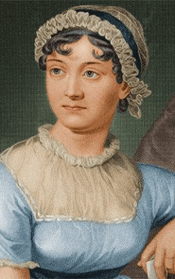What Devonshire House
was to the late eighteenth century, Holland House was to the early nineteenth
century. And then some. Holland House has been called the closest thing
England ever had to a continental salon. For Holland House, in the first
40 years of the nineteenth century, referred not only to the house built in
1605 but to a gathering place of the era's movers and shakers.
This photo of Holland House was likely taken at the turn of the 20th century.
Holland House was
built in the seventeenth century by Sir Walter Cope and was originally called
Cope Castle. The baronet's gracious, turreted three-storey structure was placed
upon a hill surveying his vast parkland in what is now Kensington.
Though only two miles
from the present Marble Arch of central London's Hyde Park, that part of
Kensington was considered "country" even later in Regency
times. In fact, the 3rd Lord Holland (whose 40 plus years of
dinners made Holland House internationally famous) always rented a house in the
city during Parliamentary sessions. (Three miles through bustling London with
its hundreds of toll gates was an arduous journey well into the nineteenth
century.)
Sometime after Sir
Walter Cope's death, the house passed to the first Earl of Holland, whose
title became extinct. However, the title was revived by eighteenth-century
politician Henry Fox (1705-1774), who became the first Baron Holland after
purchasing the house. Enormously wealthy (until his sons squandered his money
gambling), Fox eloped in 1744 with the Duke of Richmond's daughter, Lady
Caroline Lennox, who was 18 years his junior.
The most famous of
their three (spoiled) sons was Charles James Fox, who was elected to Parliament
before he was 21 and led the Whig party until his 1806 death. After the early
death of Charles James Fox's older brother, Stephen, the Holland title passed
to his young son, the 3rd Lord Holland (1773-1840). It is he who
brought prominence to Holland House. He enjoyed an especially close
relationship to his uncle, Charles James Fox, who had no legitimate children.
Having succeeded to
the title while still a boy, the 3rd Lord Holland fell in love with Sir Godfrey
Webster's wife while traveling in Italy before his twenty-first birthday. After
her divorce, she and Holland married in 1797—but not before the birth of their
first child, Charles Fox, named for the uncle Holland idolized throughout his
life. (Her first husband kept the children from that marriage.)
Likely because
as a divorced woman, Lady Elizabeth Holland (whose journal review can be found
on my website) could not be received in polite society, she began presiding
over dinners at her new home with other "Foxite" Whigs. These dinners
grew to include the most interesting men of the era: important Tories, visiting
Europeans of prominence—including heads of state—and some of the greatest
writers of the nineteenth century.
The massive home was
filled with portraits of nineteenth-century notables who exchanged portraits
with the Hollands, which was a custom of the day. (The exchanged portraits were
typically copies of portraits by more well known painters.)
Lady Holland kept
“dinner books” for 40 years—virtually a People magazine of early
nineteenth-century England.
Sadly, the Holland
title went extinct when the 3rd Lord Holland's son and heir died
childless in 1859, nineteen years after succeeding his father. He left Holland
House to his widow, urging her to keep the historical structure and its
priceless contents intact. Upon his widow's death 30 years later, she left
Holland House to the 5th Earl of Ilchester, a member of the Fox
family. She had turned down opportunities to sell it or its contents in respect
of her late husband's wishes.
The wealthy Lord
Ilchester had previously worked out an agreement with the last Lady Holland to
give her a generous annuity and to be responsible for the upkeep on the house
until her death. Also, he agreed that when he took possession of the residence
he would keep the house and its immediately surrounding property as she left
it.
Cheryl Bolen peers at what's left on Holland House on her recent trip to England. The hostel is located in the heart of London's beautiful Holland Park.
That Lord Ilchester's
son, the talented author of the two-volume history of Holland House, came into
possession of Holland House on his mother's death in 1935. Little did he know
when writing the saga of Holland House that German bombs would destroy it in
1940, two years after his second volume was published.
Only one of the
rambling mansion’s wings was not destroyed, and this is now a youth hostle.
Also, an original arcade and orangery remain. These structures are surrounded
by a beautifully landscaped 54-acre park which is maintained by the Royal
Borough of Kensington and Chelsea and which is now close to the center of
bustling London. Holland Park is a must-see.
The 6th
Lord Ilchester sold the ruin and land to London City Council in 1952.
I have not been able
to learn if he was able to save the house's treasures or the dozens of
portraits it held.
One treasure that
will always be preserved for posterity is Lord Ilchester’s painstaking research
about Holland House. -- by Cheryl Bolen -- author of the Regent Mysteries






